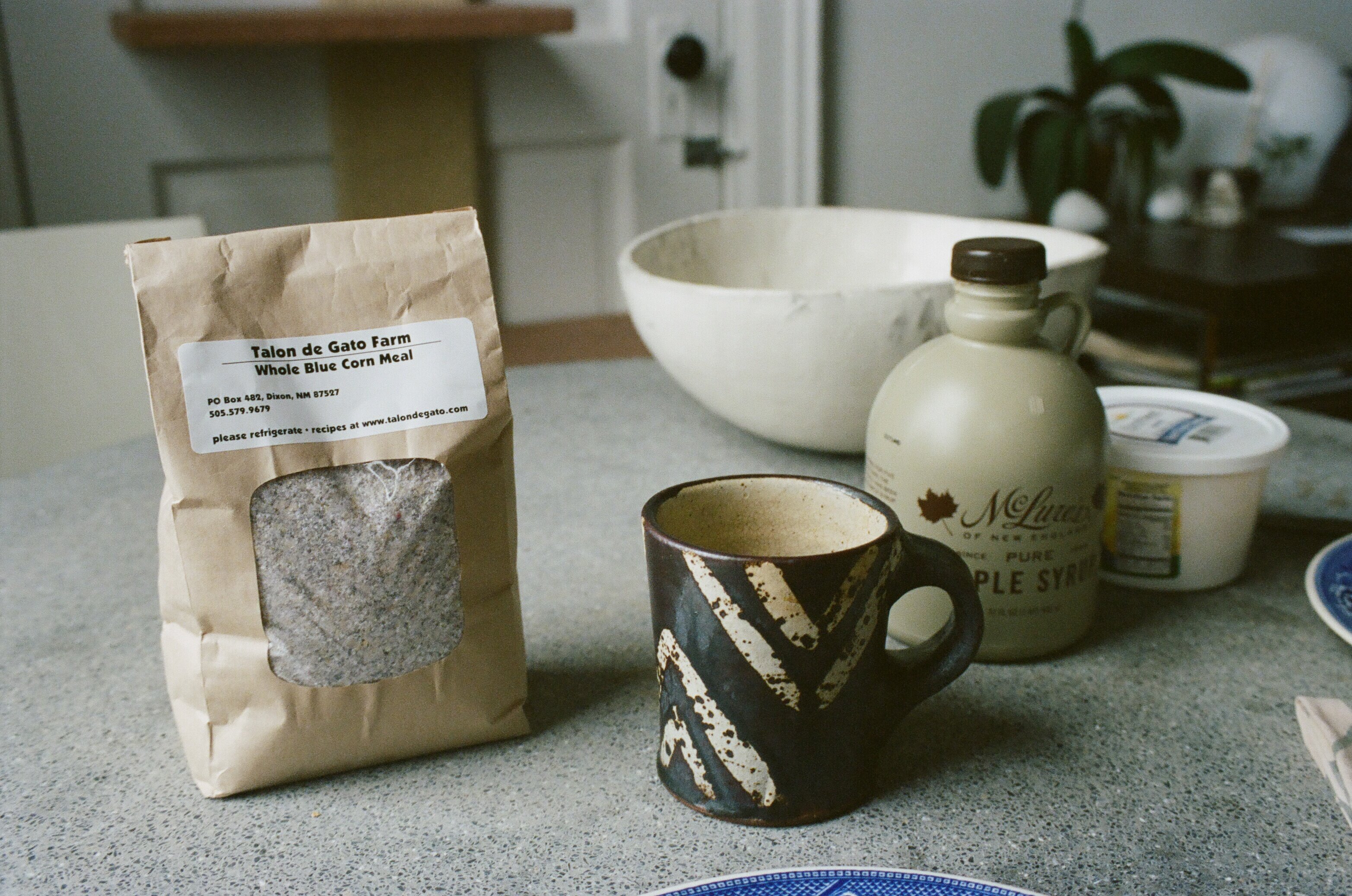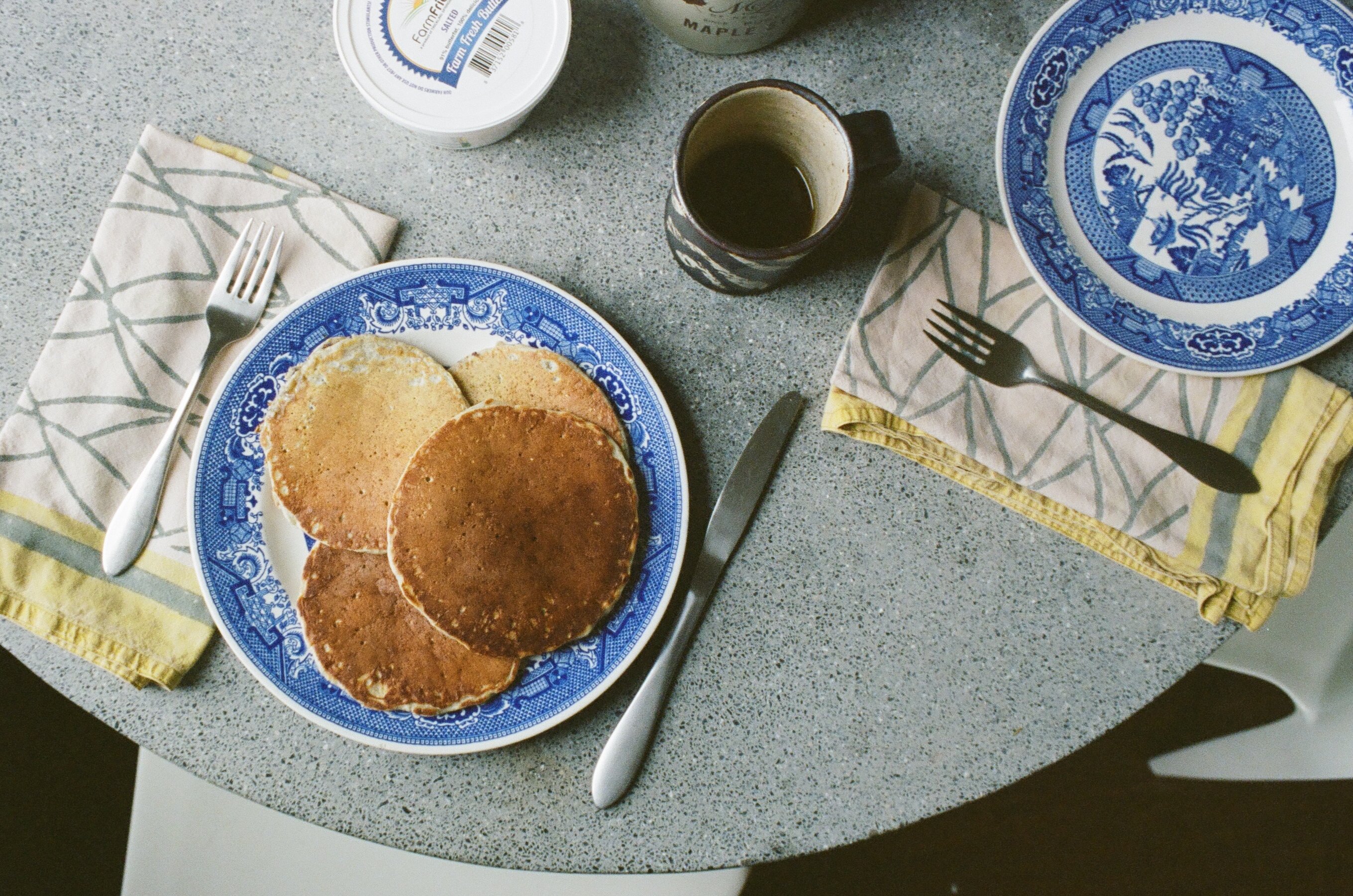When we were in Santa Fe last October, O and I spent our last morning at the farmers market down by the rail yard. With our body clocks still set to two hours ahead on East Coast time and our bellies empty and growling, we were among the first people to arrive.
I love visiting markets whenever I travel, because the character of the place emerges with more honesty and clarity than you’ll find almost anywhere else. Roasting green chiles blackened and blistered in rotating metal drums, and then were packed into plastic baggies and handed to the long lines of waiting and eager hands. Ristras and garlands of marigolds hung from tents and bundles of dried sage were stacked in mountains on tables beside bags of powdered chili, dried herbs, and blue cornmeal. We couldn’t bring home half of what we wanted to, but we found room in our suitcases for marigolds, herbal teas, and a couple bags of silvery blue cornmeal from Talon de Gato Farm.

Blue cornmeal tastes sweet and nutty, and nearly identical to yellow cornmeal. Ground from blue corn kernels, it owes its silvery blue color to anthocyanins, water-soluble pigments that bring vibrant shades of blue, red and purple to a variety of foods like berries, pomegranates, cherries, red cabbages and more. Anthocyanins are known for their abundant health properties, including antioxidant, anti-inflammatory, and anti-cancer.
Today, this is how blue cornmeal is revered – as a nutritional powerhouse. But blue corn has a long and sacred history among the peoples of the Americas and is one of civilization’s most ancient grains. The Hopi are sometimes called “the people of the blue corn,” and blue corn features prominently in their creation story. Along with squash and beans, corn makes up the three sister crops of the Americas, as these three plants were traditionally always planted together to mutually benefit each others’ growth. Corn provides stalks for the beans to climb up, the beans nourish the soil with nitrogen that the other plants need, and the squash provide ground cover to prevent weeds. Three sisters, three goddesses – maiden, mother, crone. Corn mother, feeding her countless children with her sacred grain.

While delicious, cornmeal on its own can be heavy, so I chose to mix some into our go-to pancake recipe to lend flavor and nutrition but keep the lightness of the pancakes intact. These pancakes have now become our favorite weekend breakfast when paired with grass-fed butter, real maple syrup and mugs of hot coffee. If you can’t find blue cornmeal in your local grocery or health-food store, you may be able to buy it online from a Southwestern supplier or a larger manufacturer like Bob’s Red Mill or Arrowhead Mills. It will be worth the hunt.
blue cornmeal pancakes
makes 8-10 pancakes
1 cup white flour
1/2 cup blue cornmeal
1 Tablespoon sugar
1 3/4 Tablespoons baking powder
pinch of sea salt
1 1/2 cups whole milk
3 Tablespoons unsalted butter, melted, plus more for greasing the skillet and serving
2 organic eggs
maple syrup, for serving
In a small bowl, mix together the dry ingredients – flour, blue cornmeal, sugar, baking powder and salt. In a medium bowl, whisk together the wet ingredients – milk, melted butter and eggs. Incorporate the dry ingredients into the wet and stir until just combined. Do not overmix – some flour lumps might still remain and that’s okay.
Heat a large skillet over medium heat. It’s hot enough when a few drops of cold water sizzle and sputters on the pan. Grease the skillet with 1-2 Tablespoons of butter. Using a size 1/3 cup measuring cup, ladle pancake batter onto the skillet, two at a time and spaced apart to avoid them spreading into each other. When the uncooked side of the pancake is covered in air bubbles, about 3 minutes. Use a spatula to flip it over and cook the other side, which will take about half as long as the first side. If the pancakes are too dark, lower the heat; if they’re too light and are taking long to cook, increase the heat slightly.
Once done, serve the pancakes immediately or keep them in a warmed oven (at 200 F) until all pancakes are fried up and ready to eat.

